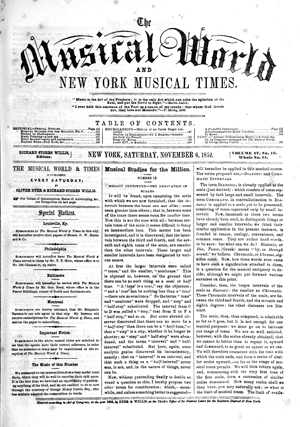The New York Musical World
Includes:
- The Musical World and New York Musical Times (1852-1854)
- The Musical World and Times (1852-1854)
- The Musical World (1854)
- Musical World. A Weekly Journal for "Heavenly Music's Earthly Friends" (1855)
- Musical World. A Journal for "Heavenly Music's Earthly Friends" (1855)
- The Musical World (1858-1860)
- Complete Introduction: English

Prepared by David A. Day
(1993)

The New York Musical World contains an exceptionally rich repository of information about the musical life of the United States in the 1850s. A continuation of The Message Bird (1849-1852), The New York Musical World changed both its title and editor several times. It appeared weekly until 21 July 1860 when it united with the New York Musical Review to form the Musical Review and Musical World. At various times the journal was edited by Oliver Dyer, Richard Storrs Willis, August Morand, Edward Hodges and J. H. Wardell. From the beginning until the last few months of publication, Richard Storrs Willis appears to have guided the journal’s editorial policies. His own writings dominate The New York Musical World’s contents through 1854, and the journal’s longest running series of articles is Willis’ “Musical Studies for the Million,” weekly texts presenting rudiments of music theory and harmony. Willis’ interest in composition is evident in reviews of new music such as Lowell Mason’s Carmina sacra. In 1858 Willis’ collection of church service music appeared in installments. Aspects of Willis’ personal life and musical training are occasionally revealed in the series of sketches “Portfolio of a Musical Bachelor” containing a recounting of his experiences as a music student in Europe and as a student at Yale University. The role of piano manufacturer Jonas Chickering in Willis’ life is discussed at the time of Chickering’s death.
The journal’s reviews and articles focus on native American and immigrant musicians and singers including the conductors Carl Anschutz, Carl Bergmann, Carl Eckert and Theodore Eisfeld; the composers George F. Bristow, William Fry, C. Jerome Hopkins, George F. Root and Robert Stoepel; pianists Richard Hoffmann, Louis Moreau Gottschalk and Robert Goldbeck; violinists the Brothers Mollenhauer; entrepreneurs Niblo, Max Maretzek, Maurice Strakosch and Bernard Ullman; singers Lucy Escott, Adelina Patti, Adelaide Phillipps, and Harrison Millard. While the journal deals primarily with musical activities in New York and Brooklyn, there are also reports from Boston, Charleston, Chicago, Cincinnati, Detroit, Milwaukee, New Orleans, Providence and Washington. An accounting of musical activities in rural areas are found in reports from Indiana, Tennessee and California. There are also reviews of famous Europeans performing in North America; among them are the singers Giulia Grisi, Mario, Constance Nantier-Didiée, Pasquale Brignoli, Anna de Lagrange, Marietta Piccolomini, Anna Bishop, Cesare Badiali and Carl Formes; Louisa Pyne and William; the conductors Luigi Arditi and Emanuele Muzio, and instrumentalists Ole Bull, Charles Bochsa, Paul Julien and Alfred Jaell.
The journal contains articles and letters from a number of well-known American writers: for example, Lowell Mason reporting on English musical festivals, and composer William Henry Fry reporting from Paris and providing lectures on music history. Willis’ editorial on the role of the New York Philharmonic Society in promoting the works of American composers evoked heated responses from George F. Bristow and John Sullivan Dwight. The British-born organist of Trinity Church, New York, Edward Hodges contributed valuable articles on church music. Carlo Bassini produced two extended series of articles related to voice production, while Gustav Schilling’s methodology of teaching music was published in serial form. Music supplements, in most issues, consist of salon pieces for voice and piano or guitar, simple piano pieces, sacred and secular choral pieces, and arrangements of popular operatic arias by Donizetti, Rossini and Verdi. A number of original compositions by American composers are also included.
